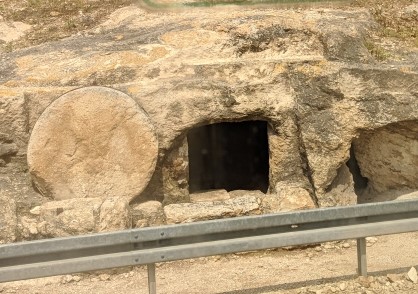My wife and I recently returned from a tour of Israel. The whole trip was amazing. We were overwhelmed by all the sights and sounds and the sheer spiritual magnitude of the trip. It was hosted by Michael W. Smith and included, among others, worship times lead by him at the southern steps of the Temple Mount, the Mount of Beatitudes, and the Sea of Galilee.
While we were there we also encountered two versions of where Jesus Christ may have been crucified and buried. Our guide presented both to us, touring us through both locations and carefully avoiding any declaration of which one he believed to be correct. Rather he asked us to prayerfully consider both and see which we felt to be true in our spirits.
The more prominent and well known was the Church of the Holy Sepulchre. This site was chosen after Helena, the mother of Constantine, the first Roman emperor to convert to Christianity, had a dream that it was there that Christ had died. When excavating the site, three ancient wooden crosses were found. Given that the Romans likely crucified thousands after the fall of Jerusalem in 70 AD, this should not actually be that surprising.
While the Church of the Holy Sepulchre is on a hill, (Jerusalem is build on a hundred hills), there is no large rocky prominence. There is a large boulder inside the church and this is traditionally believed to be where the Crucifixion took place. It is said that when Christ died his blood ran down and split the rock, revealing Adam’s skull at its base. Hence the Place of the Skull or Golgotha. The Church was a beautiful old building but one whose history has been marred by infighting, violence and even death amongst the different denominations vying for influence and supremacy.
The other site was the Garden Tomb. This is located by a large rocky outcrop which clearly resembles a human skull. This appearance was even more definite in the past, prior to an earthquake which damaged the hill and broke off its “nose”. Photographs of the locale give easy credence to it being the Place of the Skull.
Within a short distance of the hill, archeological digs have revealed evidence of an ancient garden and vineyard, including a wine press, dating from the time of Christ. Mere meters away from the wine press is a tomb carved into the rock. While the round stone used to bar the entrance is gone, the track in which is was laid is clearly visible. A tomb such of this would have belonged to a wealthy family or individual—such as Joseph of Arimathea.
Ultimately however, it really does not matter where Christ was crucified; where he was buried. What matters is that he willingly went to the cross and paid the price—the price for our salvation. He died and was buried. But three days later he rose again. Death was defeated and a new covenant was made, sealed by his blood. A way for us to have our sins forgiven, to become adopted children of God, and to have eternal life.
That’s what does matter.

